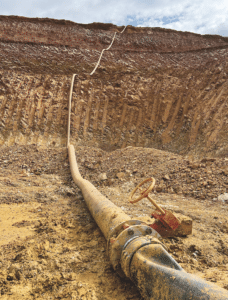In harsh mining environments, the robustness and reliability of equipment for transporting fluids is paramount.
The last three decades have seen Crusader Hose’s layflat hose systems emerge as a preferred solution for an increasing number of mining companies in Australia.
“With exceptional strength, flexibility, and ease of installation, the layflat hose offers significant advantages over traditional poly pipe,” Crusader Hose said. “Its superiority in crucial requirements of hardiness, manoeuvrability and performance reinforces its place in the mining sector.”
Crusader Hose’s Waterlord and Waterlord Extra are engineered to withstand the rigours of mining environments.
Waterlord is a heavy-duty layflat hose manufactured by weaving a textile reinforcement of high-tensile polyester, then extruded with abrasion-resistant polyurethane. The tough cover protects the hose against damage from most rocks and soils.
This robust construction allows the hose to handle high-pressure applications without compromising its integrity. Available in lengths of up to 200m, it is “ideal for overland pipelines”.
“Based on feedback from our existing Waterlord clients, we have introduced an extra abrasion protection hose to the Waterlord family,” Crusader Hose said.
“Waterlord Extra has a double skin that is crafted by inserting a Waterlord hose inside another. The outer hose forms a loose second skin which protects the inside Waterlord from abrasion damage across particularly rugged terrain.
“As always, care must be taken to ensure that the hose is ideally flat and not kinked when dragged across the ground to ensure maximum efficiency and effectiveness.”
The flexible construction of the hose enables it to be deployed across varied landscapes, including high walls and rocky terrain, dragging down steep inclines and benches.

Image: Crusader Hose
Unlike poly pipe, the rigidity of which requires significant anchoring, welding and specialised equipment to deploy, Waterlord layflat hose has a tight bend radius. This, according to Crusader Hose, allows it to adapt to diverse topography and snake easily around bends, reducing the likelihood of kinking.
“Transporting and unloading traditional poly pipe can be a time-consuming and potentially hazardous task,” the company said. “Restricted to finite lengths in its design, loading and unloading pipe onto numerous trucks for transportation can be arduous and dangerous.”
Layflat hose, on the other hand, is transported in round coils, enabling more to be loaded onto one truck.
“Four kilometres of layflat hose requires only one truck for transportation, compared to a minimum of nine trucks for HDPE (high-density polyethylene),” Crusader Hose said. “That’s a considerable saving in space, person power, truck availability and costs.
“Three operators can deploy and connect five to 10 kilometres of layflat hose in just one day. The durability of layflat hose ensures long-term performance, allowing it to be seamlessly re-used in different locations within a mine.”
The couplings designed by Crusader Hose for its Waterlord hose family are engineered for precision and reliability. With high-tech features, the Boa clamps can sustain high pressures. These couplings and clamps are easy to fit and connect on-site.
“Crusader Hose is committed to quality control,” the company said. “Every hose is tested in our quality assurance facility for reliability and performance.
“All our hoses are hydrostatically tested prior to dispatch by our accredited hydrostatic facility that can test up to 7400kPa pressure.
“We understand the need for operational efficiency in mine dewatering and for reliable, easy-to-use equipment to reinforce worker safety compliance.”
Crusader describes its layflat hose as a “game-changer” for mining operations.
“Its exceptional strength, flexibility and ease of installation provide significant advantages,” the company said. “Its ability to manoeuvre over abrasive terrain, withstand high pressures, and provide a safe and efficient installation process sets it apart from traditional poly pipe.
“By choosing Crusader layflat hose, mining operators can enhance their operational efficiency, rely on quality products that are built to last, and achieve long-term sustainability.”
This feature appeared in the October 2024 issue of Australian Mining.




